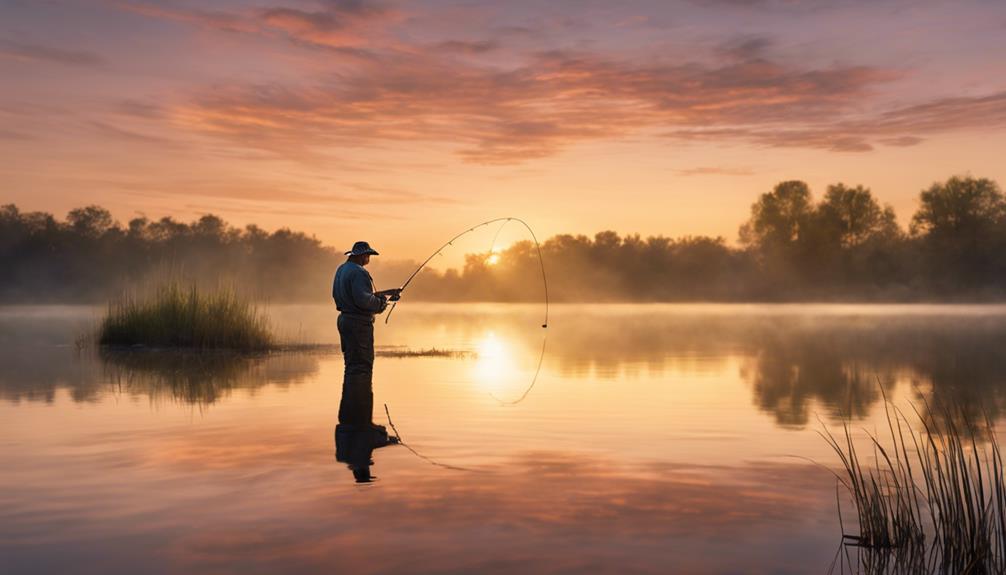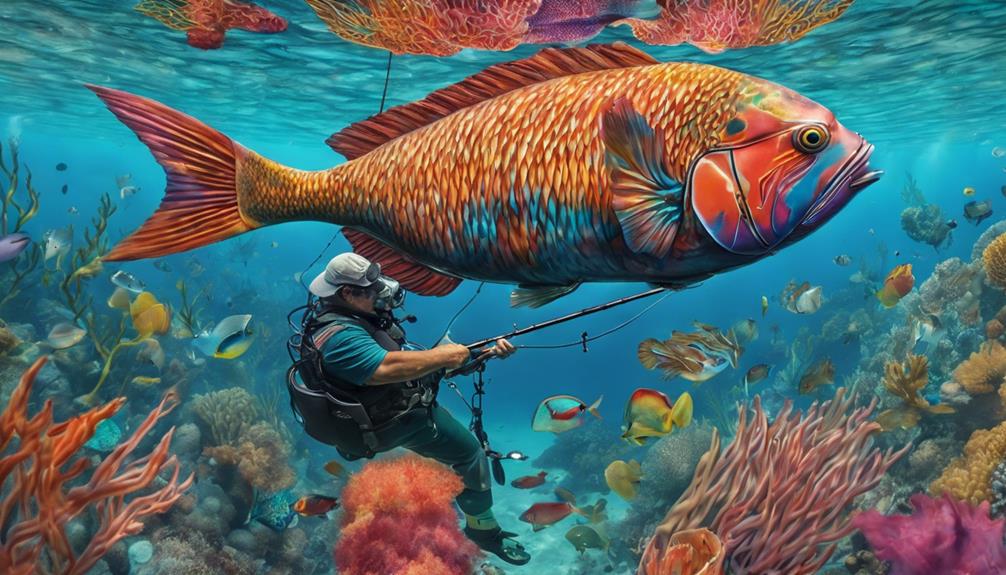With over 7 million anglers targeting catfish in the U.S. alone, it's clear that catfish angling is a popular pastime. But are you maximizing your chances of success?
From choosing the right bait to mastering different catfish species' behavior, these 11 effective strategies will help you reel in more catfish on your next fishing trip.
Get ready to elevate your catfish angling game and increase your catch rate with these proven tactics.
Choosing the Right Bait
When selecting bait for catfish angling, consider using fresh and fragrant options to attract these bottom-dwelling fish effectively. Catfish have a keen sense of smell, making the choice of bait crucial for a successful fishing trip. Popular bait selections for catfish include chicken liver, nightcrawlers, and stink bait. These options emit strong scents that can lure catfish from a distance, enticing them to bite.
When it comes to lure options, you may want to consider using artificial baits such as plastic worms or jig heads. These lures can be scented with special attractants to mimic the smell of natural bait, making them appealing to catfish. Additionally, using brightly colored lures that create vibrations in the water can help grab the attention of catfish, especially in murky or dark waters where visibility is low.
Experimenting with different bait and lure options is key to finding what works best in your specific fishing location. Catfish can be picky eaters, so having a variety of bait choices can increase your chances of a successful catch. Remember to keep your bait fresh and replace it regularly to maintain its effectiveness in attracting catfish.
Selecting the Ideal Location
To maximize your chances of a successful catfish angling experience, locate areas with ample underwater structures and depths where catfish are likely to congregate. Optimal depths for catfish angling usually range between 10 to 20 feet, as these depths provide the ideal conditions for catfish to feed and stay comfortable. Look for areas with hidden structures such as submerged logs, rock piles, sunken trees, or underwater ledges. These structures serve as hiding spots for catfish and attract baitfish, making them prime locations for catfish to lurk.
When scouting for the ideal location, pay attention to the water currents. Catfish tend to prefer slower-moving waters, so areas near bends in rivers, points where currents break, or slack water behind obstacles like boulders can be fruitful spots. Additionally, consider the presence of vegetation like water plants or algae beds, as these areas can harbor insects and small fish that catfish feed on.
In lakes or reservoirs, focus on areas where feeder creeks or streams enter the water body. These spots often have a higher concentration of nutrients and attract baitfish, which in turn draw catfish. Remember to respect any fishing regulations and obtain necessary permits before angling in specific locations. By targeting areas with optimal depths and hidden structures, you increase your chances of a successful catfish angling expedition.
Utilizing Effective Rigging Techniques
Maximize your catfish angling success by employing strategic rigging techniques that enhance your chances of a rewarding catch.
When it comes to rigging modifications, consider using slip sinker rigs for bottom fishing. These rigs allow the catfish to take the bait without feeling the weight of the sinker, increasing the chances of a successful hookset. Additionally, incorporating rattles or beads above the hook can create noise and vibrations to attract catfish, especially in murky waters where visibility is low.
Another crucial aspect of effective rigging is bait presentation. Make sure your bait is fresh and lively, as catfish are more likely to go for active prey. Utilizing circle hooks can also improve your hook-up rate, as they often result in corner-of-the-mouth hooksets, reducing the chances of the fish escaping. When presenting your bait, consider varying the depth at which it's suspended to cater to the catfish's feeding preferences. This can involve adjusting the leader length or using floats to keep the bait at the desired depth.
Mastering Different Catfish Species Behavior
Enhance your catfish angling success by understanding and mastering the behavior patterns of different catfish species. Proper species identification is crucial as each species exhibits unique feeding patterns. For instance, channel catfish are primarily scavengers and prefer food like worms and stink baits, while flathead catfish are more predatory and prefer live bait such as fish and crayfish. Knowing these distinctions can greatly improve your chances of a successful catch.
Understanding the habitat preferences of different catfish species is key to locating them effectively. Channel catfish are commonly found in rivers and streams with moderate currents, while flathead catfish prefer deep, slow-moving waters with plenty of cover like logs and rock formations. By targeting the specific habitats favored by each species, you can significantly increase your chances of hooking a big one.
Seasonal movements also play a crucial role in catfish behavior. During the warmer months, catfish tend to move to shallower waters to feed and spawn, making them more accessible to anglers. In contrast, during colder months, catfish often retreat to deeper waters where they're less active and harder to catch. By adjusting your fishing techniques based on the seasonal movements of different catfish species, you can adapt to their behavior patterns and improve your angling success.
Employing Proper Rod and Reel Setup
Understanding the behavior patterns of different catfish species can guide you in selecting the proper rod and reel setup for a successful angling experience. To ensure optimal performance from your equipment, consider the following key points:
- Rod and Reel Maintenance: Regular maintenance is crucial to keep your gear in top condition. Clean your rod and reel after each use, paying particular attention to removing any dirt or debris that could affect performance. Additionally, lubricate moving parts to prevent rust and ensure smooth operation.
- Proper Handling: Correct handling of your rod and reel can extend its lifespan and improve your angling experience. Avoid dropping or banging your equipment, as this can cause damage. When transporting your gear, use protective cases or covers to prevent any potential harm.
- Rod and Reel Pairing: Matching the right rod with the appropriate reel is essential for achieving optimal performance. Consider the weight and action of the rod, ensuring it complements the reel's capabilities. This pairing can enhance your casting accuracy and control during retrieval.
- Optimal Performance: By maintaining and handling your rod and reel correctly, you can expect enhanced performance on the water. A well-maintained setup will provide smooth casting, reliable drag, and overall better angling results.
Understanding Water Conditions
Regularly monitoring water conditions is essential for increasing your chances of a successful catfish angling expedition. To start, conduct a depth analysis to understand where catfish might be lurking. Different species of catfish prefer varying depths, so knowing the water's depth can guide your fishing spot selection. Additionally, pay attention to current observation; catfish often position themselves strategically to benefit from currents carrying food towards them.
Temperature awareness is crucial when angling for catfish. These fish are sensitive to temperature changes, so knowing the water temperature can help you determine their activity levels. In warmer waters, catfish tend to be more active, while they may slow down in colder temperatures. This knowledge can inform your bait choice and fishing approach.
Oxygen levels play a vital role in catfish behavior. These fish require well-oxygenated water to thrive. During hot summer months, oxygen levels may decrease, causing catfish to move to deeper, cooler areas. By understanding oxygen levels in the water you're fishing, you can adapt your strategy accordingly.
Fine-Tuning Your Casting Technique

To maximize your catfish angling success, honing your casting technique is crucial for accurately reaching potential hotspots where catfish may be lurking. Improving accuracy and adjusting distance are key factors in fine-tuning your casting technique.
- Focus on Your Casting Form: Ensure you have a smooth casting motion, with your wrist providing the necessary power while maintaining control over the distance and direction of your cast.
- Practice Makes Perfect: Regularly practice your casting technique in different conditions to improve your accuracy and distance adjustment skills.
- Use the Right Equipment: Choose a rod and reel combination that suits your casting style and the weight of the bait you'll be using to optimize your accuracy and distance.
- Pay Attention to Wind and Current: Adjust your casting technique based on the wind direction and strength, as well as the water current, to accurately place your bait where the catfish are likely to be.
Implementing Stealthy Approaches
For improved success in catfish angling, employing stealthy approaches can significantly enhance your chances of luring in cautious catfish. When it comes to catfish angling, a silent approach and the use of camouflage gear are crucial elements to consider. Catfish are known for being sensitive to vibrations and disturbances in their environment. By moving quietly and blending in with your surroundings through the use of appropriate gear, you can avoid alerting the catfish to your presence and increase your chances of a successful catch.
In addition to a silent approach and camouflage gear, practicing patience and strategic positioning are key strategies for implementing stealthy approaches in catfish angling. Catfish are often cautious and may take time to approach bait. By patiently waiting for the catfish to strike and resisting the urge to make sudden movements, you can increase your chances of a successful hookset. Furthermore, strategic positioning near areas where catfish are likely to feed or hide, such as underwater structures or vegetation, can improve your chances of attracting catfish.
Frequently Asked Questions
What Are Some Common Mistakes to Avoid When Fishing for Catfish?
When fishing for catfish, avoid common mistakes like using the wrong bait selection or hook size. Patience is key, so don't rush the process.
Location choice plays a vital role in your success. Make sure to pick spots where catfish are likely to be present.
How Can Weather Conditions Impact Catfish Angling Success?
When it comes to catfish angling, weather conditions play a crucial role in your success. Barometric pressure, temperature, wind speed, and cloud cover can all impact the behavior of catfish.
Pay attention to changes in these factors as they can influence where the catfish are located and how active they are.
Are There Any Specific Time of Day That Is Best for Catfish Fishing?
When it comes to catfish fishing, the best time of day to catch them is typically early morning or late evening. During these times, catfish are more active and likely to bite.
Using the best bait, such as worms or chicken livers, can increase your chances of success. Make sure you have ideal equipment like a sturdy rod and reel to handle these big fish.
Patience and persistence are key to reeling in those catfish!
How Important Is It to Consider the Moon Phase When Planning a Catfish Fishing Trip?
When planning your catfish fishing trip, considering the moon phase is crucial. The moon phase influences catfish behavior and feeding habits.
Lunar cycles can affect how active catfish are and when they're more likely to bite. By paying attention to the moon phase, you can increase your chances of a successful angling experience.
What Are Some Effective Ways to Handle and Release Catfish After Catching Them?
When you catch a catfish, remember to handle it properly for a safe release. Use wet hands to avoid damaging their protective slime coat.
Support their body correctly to reduce stress. For a successful catch and release, gently place the catfish back in the water.
Conclusion
So there you have it – with the right bait, location, rigging techniques, and knowledge of catfish behavior, you can increase your chances of success in catfish angling. Remember to pay attention to water conditions, master your casting technique, and approach stealthily for the best results.
By implementing these strategies, you'll be well on your way to reeling in some big catfish on your next fishing trip. Happy angling!



